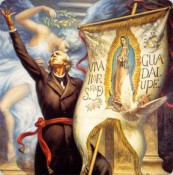By: Daniel Nardini
 A friend told me of one case he knows where a friend of his from Mexico would regularly attend classes to learn—Spanish! Yes, his friend was born and raised in Mexico. Yes, his friend had lived there a good part of his life. But he never learned Spanish. It is ironic that now that he is in the United States he is learning Spanish. He also intends to learn English.
A friend told me of one case he knows where a friend of his from Mexico would regularly attend classes to learn—Spanish! Yes, his friend was born and raised in Mexico. Yes, his friend had lived there a good part of his life. But he never learned Spanish. It is ironic that now that he is in the United States he is learning Spanish. He also intends to learn English.
If this tale may sound strange to some of my readers, it should not be. A growing number of people from Mexico are coming from native indigenous communities where they learn native Amerindian languages like Nahuatl, Tzotzil Mayan, Zapotec, Otomi, Mixteco, etc. Those who came from such native indigenous communities grew up with the languages of their communities and were educated in the languages of their communities. In all that time they did not learn Spanish.
Like so many Mexicans, many of the people from these native indigenous communities have also migrated to the United States to find work, and maybe a better life. Many came legally. Yet because they cannot speak Spanish they cannot communicate even with fellow Mexicans never mind with Americans. So these Mexican indigenous peoples may find themselves as isolated within certain communities in the United States as they were in Mexico. Even doing such simple things like taking a bus, going shopping, and seeing a doctor can be difficult if not traumatic.
In short, America has inherited a problem that was created in Mexico. It is estimated that New York City alone may have between 100,000 to 400,000 Mexicans who do not speak Spanish. And as for Chicago? That remains unknown. Many Mexicans will probably not identify themselves as indigenous Mexican, and others will not admit they cannot speak Spanish or only know a little Spanish. Another problem is that many indigenous Mexicans, as in the case of many Mexicans in general, are undocumented. Since they do not officially exist they are not counted and are therefore hidden from view even in their own local communities.
There are some partial solutions. One thing I have noted since the 1990’s is the explosive growth of Spanish language classes in Chicago and in the Chicago metropolitan area. Many who attend these classes are Latinos who were born and raised in the United States and want to have more contact with their ancestral roots. Others include Mexicans who did not learn to read and write Spanish and are trying to do so now. And indigenous Mexicans are also taking the opportunity to learn Spanish so they can become part of the larger Mexican immigrant communities they may be in. In turn, this helps Mexican immigrants—regardless of who they are—to eventually try to learn English since many places also offer English classes.
There are no easy solutions to this problem. However, a growing number of Mexican immigrants—both legal and undocumented—are trying to overcome a variety of boundaries in order to become a part of this country and also find better economic opportunities. There are a growing number of indigenous Mexicans who realize that being in the United States does not mean they have to be stuck in the same isolated roles they had lived in in Mexico.











